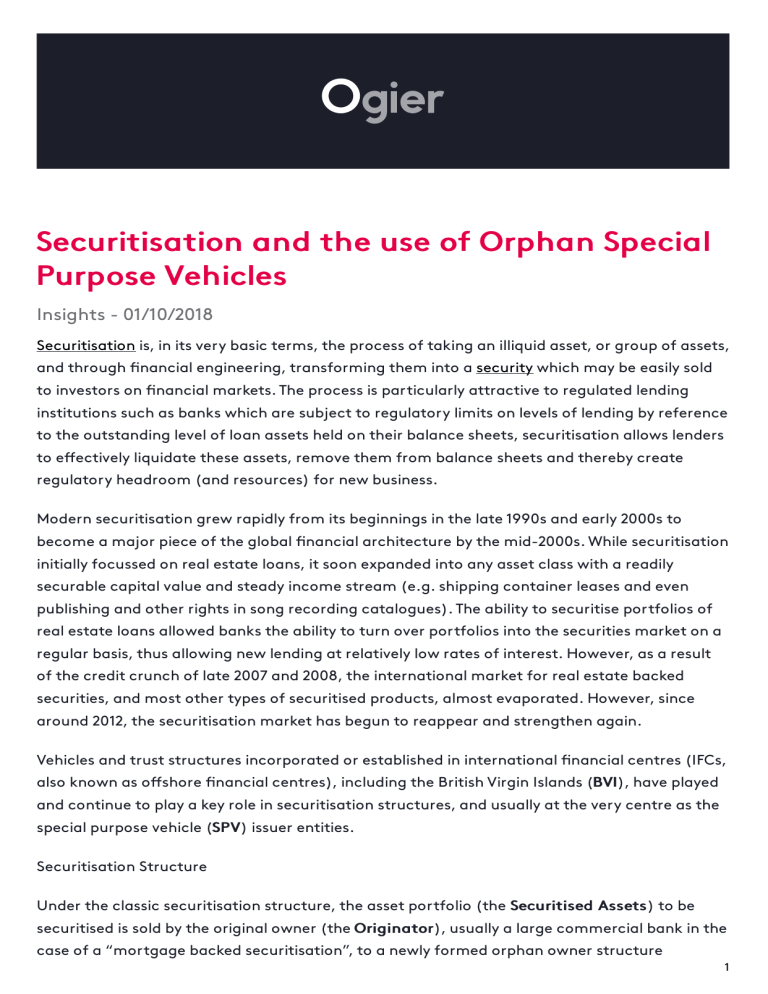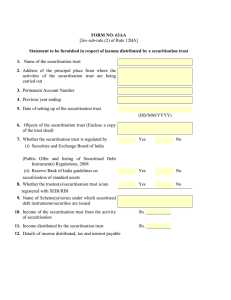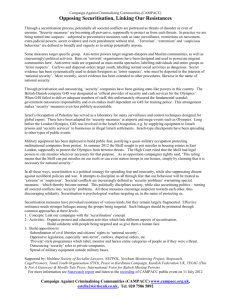
Securitisation and the use of Orphan Special Purpose Vehicles Insights - 01/10/2018 Securitisation is, in its very basic terms, the process of taking an illiquid asset, or group of assets, and through nancial engineering, transforming them into a security which may be easily sold to investors on nancial markets. The process is particularly attractive to regulated lending institutions such as banks which are subject to regulatory limits on levels of lending by reference to the outstanding level of loan assets held on their balance sheets, securitisation allows lenders to e ectively liquidate these assets, remove them from balance sheets and thereby create regulatory headroom (and resources) for new business. Modern securitisation grew rapidly from its beginnings in the late 1990s and early 2000s to become a major piece of the global nancial architecture by the mid-2000s. While securitisation initially focussed on real estate loans, it soon expanded into any asset class with a readily securable capital value and steady income stream (e.g. shipping container leases and even publishing and other rights in song recording catalogues). The ability to securitise portfolios of real estate loans allowed banks the ability to turn over portfolios into the securities market on a regular basis, thus allowing new lending at relatively low rates of interest. However, as a result of the credit crunch of late 2007 and 2008, the international market for real estate backed securities, and most other types of securitised products, almost evaporated. However, since around 2012, the securitisation market has begun to reappear and strengthen again. Vehicles and trust structures incorporated or established in international nancial centres (IFCs, also known as o shore nancial centres), including the British Virgin Islands (BVI), have played and continue to play a key role in securitisation structures, and usually at the very centre as the special purpose vehicle (SPV) issuer entities. Securitisation Structure Under the classic securitisation structure, the asset portfolio (the Securitised Assets) to be securitised is sold by the original owner (the Originator), usually a large commercial bank in the case of a “mortgage backed securitisation”, to a newly formed orphan owner structure 1 comprising an SPV held through a purpose trust or charitable trust (the Trust). The SPV will acquire the Securitised Assets pursuant to an acquisition agreement the terms of which are speci cally designed to ensure that the transaction results in a “true sale” of the Securitised Assets from the Originator to the SPV. The SPV raises the funds to acquire the Securitised Assets from the Originator by issuing notes (the Notes) secured by the SPV’s future title to the Securitised Assets, which will included all mortgages, charges and other security interests by which those assets are secured, to a pre-arranged group of investors (the Investors). In most cases, the Notes will be listed on an exchange to ensure ease of transfer and promote liquidity once in the hands of the Investors. Special Purpose Vehicle and Orphan Status As mentioned, the SPV issuer will form part of an “orphan owner structure”, that is that both it and its ownership will be structured such that the SPV is not a liated with the Originator or any of its group. This is to ensure “true sale” treatment and independence. The orphan owner structure for the SPV is achieved by utilizing the Trust as the ultimate bene cial owner of the SPV. The ”true sale” combined with the independence of the SPV confers protection from the Originator’s insolvency enhancing the “bankruptcy remote” status of the structure. Sales of Securitised Assets that do not meet particular “true sale” criteria run the risk of being recharacterised as secured loans and therefore vulnerable to attack or avoidance in any subsequent insolvency of the Originator. To achieve orphan status, the sole shareholder of the SPV typically will be a Trust controlled by a corporate trustee. Alternatively in certain securitisation structures a dedicated trustee company entity may be interposed between the Trust and the SPV. Trusts used to hold SPV orphan structures were initially established as charitable trusts and while this is still the case where English or other onshore structures are used, where the SPV is incorporated in one of the main IFCs, purpose trust structures have increasingly become the norm. The directors of the SPV are often independent professional directors provided by a dedicated corporate services provider with experience in securitisation structures. In some cases a representative of the Originator may be included, however, in practical terms, because of the terms of the transactional documents governing the overall securitisation structure, the board of the SPV have little room for further decision making and are simply bound to implement the mechanics of the transaction documents. The constitutional documents and trust arrangements governing the SPV or to which it is subject can further limit the board’s room for action. Once the Notes are issued and the Securitised Assets acquired, the role of the SPV itself becomes limited (usually through contractual arrangements with a dedicated servicing entity) to the mere distribution of income from the Securitised Assets pursuant to the terms of the trust deed (the Note Trust Deed) constituting the Notes (and this activity itself is carried out be third party functionaries under fairly standard contractual arrangements). Once the Notes are paid out or otherwise discharged, the SPV is wound-up and the remaining assets (usually a nominal 2 amount) are distributed to the Trust as the sole shareholder. Those assets are then distributed in turn to a designated charity under terms of the deed governing the Trust. Any surplus is generally distributed to charity whether the Trust is established speci cally as charitable trust or just a purpose trust. The preference for the use of purpose trusts rather than dedicated charitable trusts arose from concerns that, as there was no distribution to the designated charity until the nal distribution from the winding-up of the SPV, questions may be raised as to whether there was a truly “charitable purpose” to the Trust. As a result Trusts used in securitisation structures using entities incorporated in an IFC are usually structured as purpose trusts. Unlike charitable trusts that are created for a speci c bene ciary, purpose trusts are established for a speci c purpose and do not have to have any ascertainable bene ciary other than a residuary bene ciary (this usually a charity but can in fact be any person or type of person speci ed by the trust documents or selected by the trustee) nominated to bene t upon the winding up of the SPV and the termination of the Trust. While di culties can arise if one tries to establish and structure purpose trusts under English law or the laws of certain other jurisdictions, the laws of most of the main IFC jurisdictions, including the BVI, clearly recognise purpose trusts and allow for their relative ease of use as orphan SPV shareholders in securitisation transactions. The deed settling the purpose trust (Trust Deed) can be drafted in such a way as to clearly delineate the purpose of the Trust (and therefore the duties of the Trustee) and the restrictions imposed on it in the context the securitisation, including restrictions or obligations on the exercise of shareholder powers in relation to the SPV. In the case of a purpose trust established under BVI law, an “enforcer” of the Trust is appointed pursuant to the Trust Deed (this may be a corporation or an individual) whose role is to ensure that the trustee observes the terms of the Trust. The Trust Deed can also enhance the bankruptcy remoteness of the SPV by providing that the trustee will not take any action to windup the SPV without the express consent of the enforcer. The role of enforcer will often be taken by the lead arranger or deal agent in the securitisation. Advantages of BVI SPV Issuers and Trust Structures The BVI o ers a number of advantages as a jurisdiction for securitisation SPVs and orphan trust structures. These include:· The establishment and maintenance of a BVI company is straightforward. The company can be incorporated on a same day basis subject the necessary client KYC and AML information being received. · Provided that the SPV is structured in the conventional manner, it will not be subject to the additional licensing or regulation in BVI applicable to entities involved in certain nancial services activities. 3 · The BVI is a tax neutral jurisdiction and, as such (provided that the company has no physical establishment, employees or land in the BVI) no corporation tax, income tax, capital gains tax, inheritance tax, gift tax, or any other tax is payable by the company or in relation to its transactions in the British Virgin Islands. · There are no minimum capital requirements for a BVI company under the laws of BVI (except in the case of certain regulated entities – which ought not to include a conventional securitisation SPV). · BVI companies are not required to have locally resident directors and neither are they required to hold meetings or conduct other business in the BVI. · BVI companies that are not involved in certain speci c regulated nancial services activities are not required by statute to prepare annual accounts or to le accounts in the BVI. · BVI trusts legislation speci cally recognises purpose trusts and also o ers the provisions of the Virgin Islands Special Trusts Act (VISTA). Trusts structured under the VISTA rules o er a number of legal advantages for securitisation purpose trusts, allowing, for example, trustees usual duciary duties and powers to be limited by the terms of the Trust Deed in order to re ect the controls imposed by the overall securitisation structure and transaction documents. As mentioned, above the Notes issued by securitisation issuers are usually listed on a stock exchange. BVI entities now have a long history of being listed vehicles and such entities and the securities issued by them, debt and equity, are listed on, and therefore familiar to, many of the world’s leading investment exchanges. About Ogier Ogier is a professional services rm with the knowledge and expertise to handle the most demanding and complex transactions and provide expert, e cient and cost-e ective services to all our clients. We regularly win awards for the quality of our client service, our work and our people. Disclaimer This client brie ng has been prepared for clients and professional associates of Ogier. The information and expressions of opinion which it contains are not intended to be a comprehensive study or to provide legal advice and should not be treated as a substitute for speci c advice concerning individual situations. Regulatory information can be found under Legal Notice Meet the Author 4 Michael Killourhy Partner British Virgin Islands E: michael.killourhy@ogier.com T: +1 284 852 7309 Related Services Corporate Private Wealth Structured Finance Debt Capital Markets - Ogier Global Ogier Global Corporate and Fiduciary Legal 5






